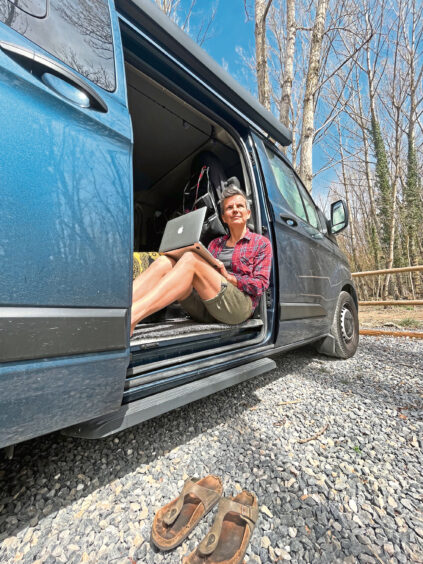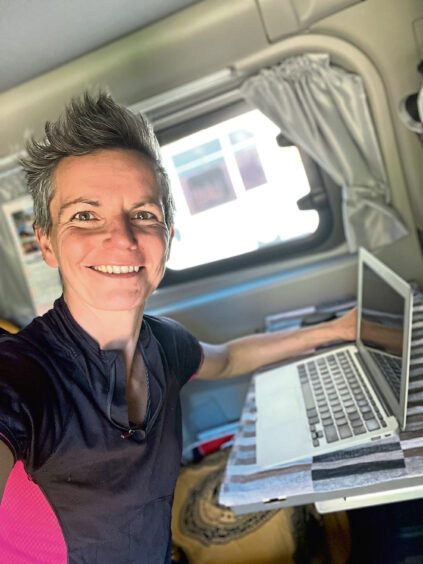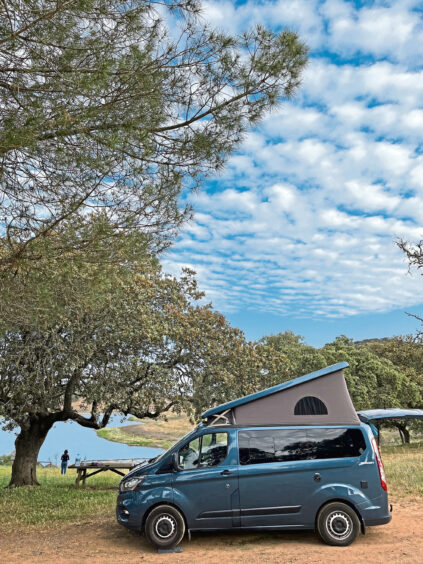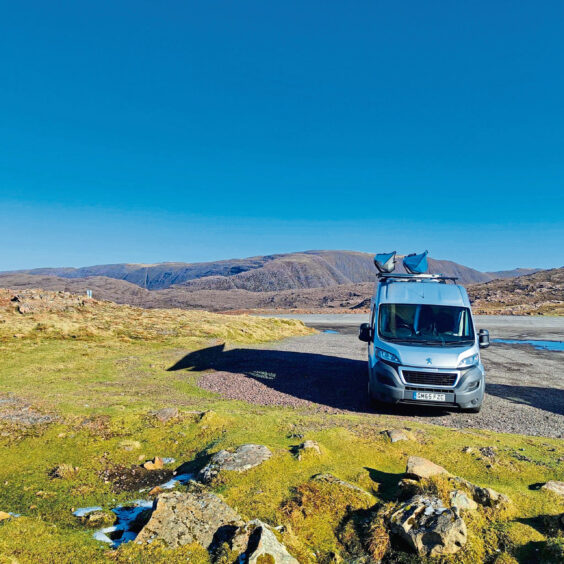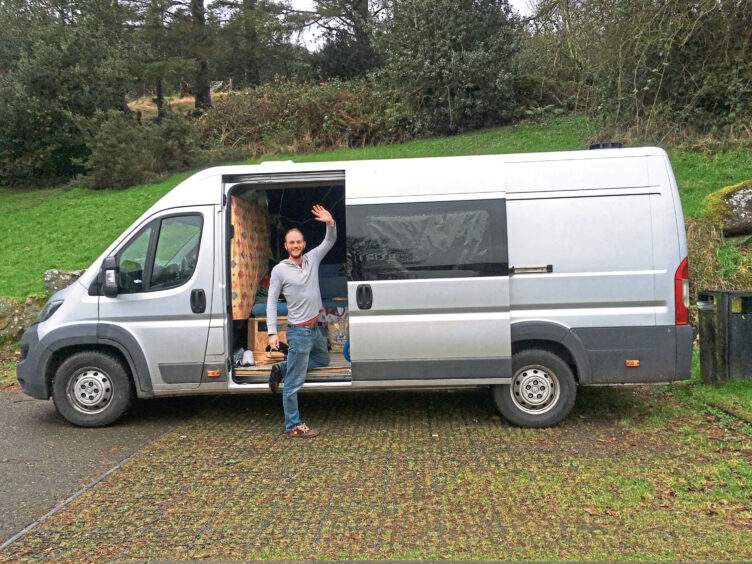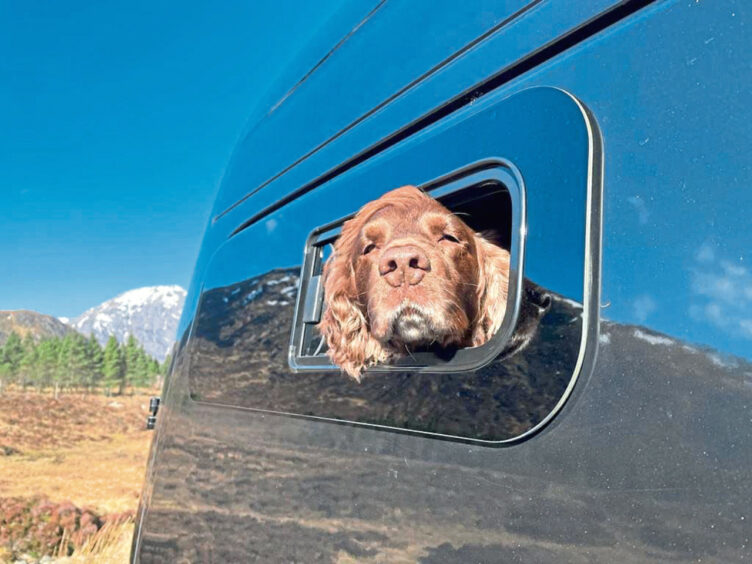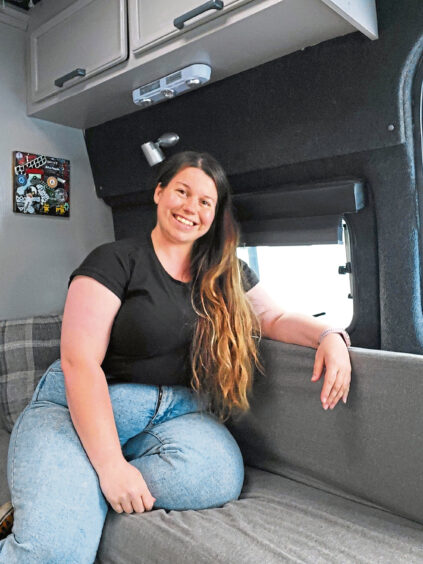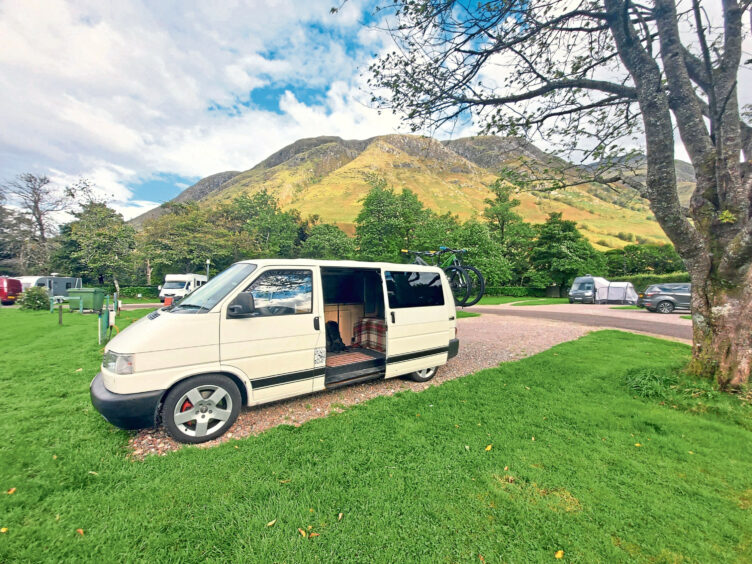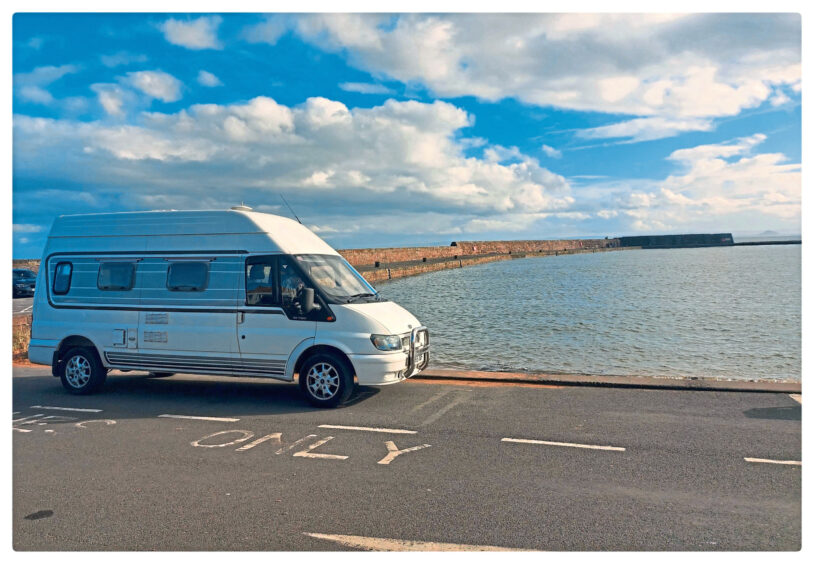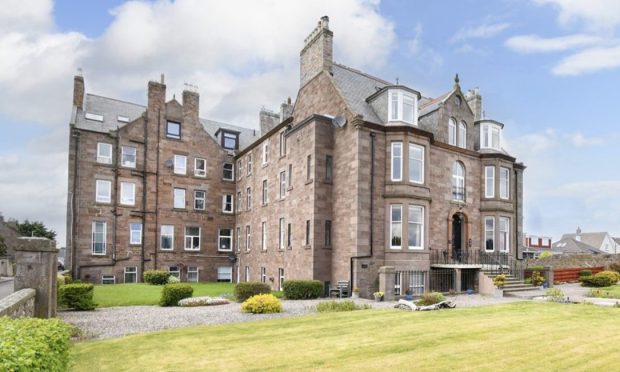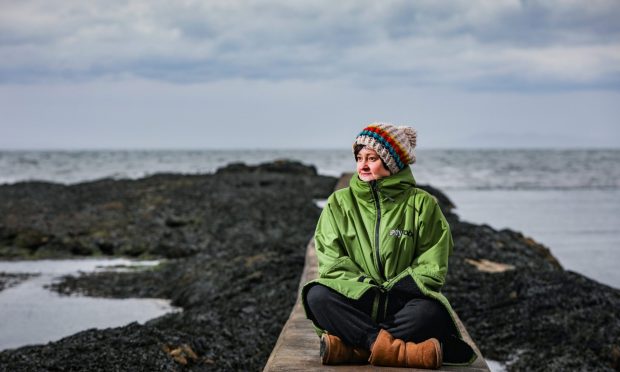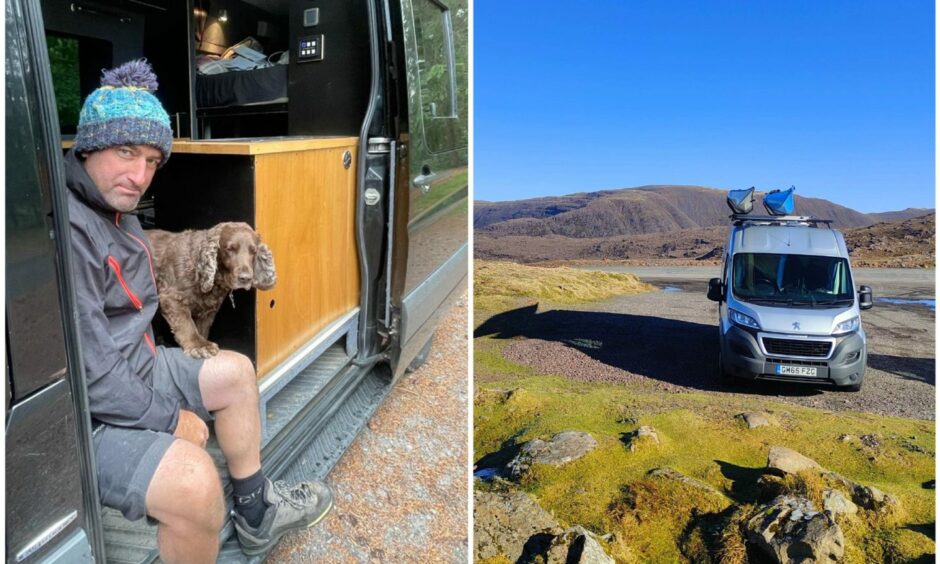
Some folk like to spend their holidays in luxury hotels, where they’re waited on hand and foot, and fall into sumptuous king-sized beds after indulging in the all-inclusive package’s vast offerings.
Others like to camp, stuffing all their belongings into a tiny polyester dome, pyramid or tunnel-shaped tent, and squeezing into a sleeping bag.
But for an increasing number of ‘van lifers’, the camper lifestyle is the way to go. Want freedom and independence? You got it! Want more comfort and convenience than camping? You got it! Want to save money? You got it!
Travel wherever you want, take what you want (yes, you can take the kitchen sink), stop where you want, and wake up with a new view every day.
Gaze at starry skies, get close to nature, enjoy sunrises and sunsets, embrace the sense of freedom, adventure and simplicity. It’s the definitive hippy dream.
Emma’s story
Former Press and Journal reporter turned author Emma Christie is travelling round Europe in her Ford Transit van, living and working in it full-time.
She abandoned her home in Barcelona (she also has a flat in Portobello, Edinburgh, and rents out several in Aberdeen) in April to head off on the life-changing trip with her girlfriend Mari Fernandez, a Spanish yoga teacher.
Their plan is to spend at least six months travelling through the Balkans, Greece and Spain.
“I love the feeling of adventure and not knowing what’s coming next,” says Emma, 42.
“We rarely use campsites so we literally have no idea where we’ll sleep every night. But I love waking up so close to nature and getting to choose a new ‘garden’ every day!”
Emma, who studied literature and medieval history at Aberdeen University before spending five years at the P&J, now works as a tour guide and lecturer in history, culture and politics with a US travel company.
It’s a career that lends itself well to campervan life, and allows her to crack on with writing her novels. She’s currently editing her third one, In Her Shadow, due for release in January 2024.
“I work really well in the van and find it super satisfying to get my writing done in the morning then spend afternoons having micro-adventures – whether biking, hiking, or exploring towns, villages and the coast,” she says. “It’s a very different rhythm of life.”
While Emma and Mari, 47, had taken short campervan trips in the past, they dreamed of an extended adventure.
“We’re both in our 40s, and thought, ‘why not now?’” says Emma.
“Last summer we travelled for six weeks in Slovenia, Bosnia and Croatia. It was the first time I’d tried to combine work and van travel.
“I wrote for three hours every morning and clocked up 50,000 words during the trip. It was a bit of an experiment but I was delighted it worked.”
Since the couple took their first camper trip in 2015, touring the Highlands for three weeks in a rented van, they’ve been addicted.
They bought their first van in 2016, a tiny Renault Kangoo with a mattress in the back and nothing more.
They’re now on their fourth van – a Ford Transit called Katie.
“She’s substantially posher than the first, with full kitchen, fridge and solar panel, pop-top roof and interior designed by Westfalia,” says Emma.
Dream van
While Katie is their ‘dream van’, the couple added a few bits and bobs to make things more comfortable – including a collapsible shower cubicle, which Emma describes as a “total game changer”, a hot water boiler, compostable toilet and bike rack.
Such relative ‘luxury’ didn’t come cheap. “It was close to 50,000 euros – a fortune – but we view it as a second home,” she says.
While there’s a huge sense of magic about van life, it’s not all plain sailing, and Emma admits the territory comes with “many challenges”.
“This van is much bigger than our first but it’s only five by two metres so it’s still a very small space for two people to live, work, cook, wash and relax. There’s always something practical to do, whether finding a place to refill the water tank or empty the toilet.
“We had our first burst tyre two minutes after entering Bosnia so it was an adventure getting it fixed in a place where we had no mobile reception, no local money and couldn’t speak the language! There’s a lot of problem solving which can be annoying but that’s also part of what we love.”
Rent one first
Any advice to folk considering buying a campervan and heading off into the sunset? Emma recommends renting one first to see how you get on.
“They can be hugely expensive and they’re definitely not for everyone,” she reasons.
“Life on the road isn’t always easy but for us the benefits massively outweigh the drawbacks. It’s strange to think of myself as a digital nomad but I suppose that’s what I am. And I love it!
* Emma’s debut novel The Silent Daughter was shortlisted for the Scottish Crime Book of the Year 2021. Her books are standalones, but set in Portobello.
Janek’s story
Adventure education lecturer Janek Mamino lived and worked in his camper for five years before buying a house in Lochaber this year. He loved the sense of freedom – the ability to head off wherever he fancied, when he fancied.
But, after five years of van life, and suffering a few bitterly cold winters, Janek, 35, decided he needed a non-mobile home.
He still intends heading off in his van, when the mood strikes – and plans to AirBnB his house when he’s away.
So, the best of both worlds, Janek? “It’s been pretty liberating,” he agrees.
“I’ve had the van, a Peugeot Boxer, since August 2018. Since I got a permanent position at West Highland College UHI in Fort William, I’ve been able to park outside and use the showers and toilets, which is handy.”
His reason for getting a campervan? He didn’t want to pay rent and loved the independence afforded by van life.
“I got the largest commercial one going – one tall enough to stand in. I got it as an empty shell and fitted everything myself. I didn’t have a clue, so I watched YouTube videos and asked questions on online forums. It was very much a case of ‘give it a go’.
“I insulated it, fitted electrics, cut holes for air vents, and fixed a double bed. I’ve got a small kitchen, running water and a gas stove.”
Cost of conversion
The 2016 model cost him £10,500 but Janek pumped a few thousand pounds into converting it.
“I needed wood for the bed and cupboards, and tried to use old pallets, and recyclable materials. I had to buy tools, screws, glue and so on, so I probably shelled out around £5,000 for everything. But considering that was my home for five years, it’s not bad!”
Pre-Covid, Janek went off on expeditions for weeks, travelling across the UK, hiking and mountain biking with friends, jumping into lochs and exploring the country.
Until a few months ago, van life was Janek’s “fixed future”. However, with a permanent job, he’s just bought a house in Spean Bridge.
“The van suited my lifestyle for a few years,” he explains. “I was never cold in bed but it could be demoralising to get going when it was -10C! “It’s not as convenient now, so it’s time for a transition. I never set it up to be a place I’d work from.
“I could invest a lot to change the van around, or, I could have a house with all the comforts, plus reliable WiFi and so on.”
Janek says anyone considering van life needs to be realistic and ask themselves whether they’ll be willing to adapt. It can be a tight, potentially claustrophobic space that quickly becomes cluttered.
“Will you be happy sitting in it on rainy days? You’ll see van life portrayed on Instagram as this idyllic thing – stopping in stunning surroundings and having the time of your life. It’s not always like that. I’ve stayed in car parks, industrial estates and residential areas.
“I know of friends who’ve had break-ins, too. You’re a little more ‘open’ to the world, which is nice, because you get sunsets and sunrises, but you need to be realistic, too. There are pros and cons.”
Allan’s story
Self-employed joiner Allan Gray is on his fifth campervan – a Mercedes Sprinter – and he’s been building them since he was in his 20s.
“I had two Ford Transits and then went down the VW Transporter T5 line,” says Allan, 48.
“I had a few mechanical problems with mine, found it too small, and got annoyed not being able to stand up, so I put a pop-top roof on it.
“I sold that at the start of Covid, before camper prices went through the roof.”
Allan, who lives in Cargill near Meikleour, then teamed up with a mechanic in Perth to work on a Mercedes Sprinter van conversion. They split the profits when they sold it.
Allan then took templates he’d had made for the van, and bought his own Sprinter for £18,000 – and spent another £6,000 doing it up.
“I put in solar panels and a full-sized bed, made up permanently – I was fed up making the bed after a few beers.
“Between work and leisure stuff, I needed to make the van work. I do a lot of mountain biking, so I needed to get two, possibly three bikes in.
“I‘ve got the dog (10-year-old cocker spaniel Brodie) so I incorporated a dog cage, and made space for a chemical toilet. I didn’t bother with a shower – you can go in a river, or head to a campsite.”
A keen snowboarder, much of Allan’s campervanning is done over winter, with him heading to Glenshee, Glencoe or the Cairngorms. His van is fully insulated, so he keeps cosy even when the temperature sinks below zero.
Another reason he’s less excited about summer trips? The midges!
“Midges kill camping!” he says. “If my partner Debbie and I do go away in summer, we tend to head to the east coast, the likes of Fortrose or Rosemarkie. It’s an escape from the midges!
“Also, keeping food and drink cool in the height of summer is a nightmare. The fridge struggles. And warm beer and wine isn’t great!”
‘A lot of down sides’ to van life
While Allan is clearly a camper fan, he admits there are a lot of ‘negatives’ around the lifestyle.
“I look forward to packing the van and heading off,” he says.
“But there’s a lot of down sides! You don’t know where you’re going, you spend the first hour looking for somewhere to camp, the next day all your food’s warm, you have to use a toilet in the van, and you stink of smoke because you’ve had a fire outside!”
While camper conversions come naturally to Allan, he says you don’t need his skill-set to have a go.
“A lot of people are good with their hands – you don’t have to be a joiner to do a great self-build,” he reiterates.
Julie’s story
From experiencing beautiful sunsets on Cairn Gorm, to stargazing in Glenshee, and watching the sun rise over Ben Lomond, Julie McKechnie can’t extol the virtues of van life enough.
“I could go on about how much joy it’s brought me and my partner, Michael, but, really, there’s nothing better than seeing the world from a sliding door with a cup of coffee, your loved one and four-legged friend,” says the 32-year-old.
Dundee-based Julie, a care assistant at a nursing home, heads into the wilderness with Michael and Staffy Django at the drop of a hat. It fulfils her desire to immerse herself in the great outdoors: she loves hill walking, wild swimming and mountain biking.
While family holidays in her childhood were often spent in tents on the west coast, she never dreamed she’d get a campervan.
“I was happy in a sleeping bag under canvas. But the practical aspects of having a camper, being able to take longer trips and not have to spend time setting up and packing away appealed to me – especially with the dog and bikes.”
Julie’s first camper was a 2001 VW T4 that she and Michael bought in 2021. It was small, rusty and they adored it.
The couple adopted a 2005 Ford Transit LWB from Julie’s parents in April, which offered more space than the T4.
Putting skills to good use
Both vans needed a wee bit of pimping up, so Michael, a mechanical and marine engineer, was able to put his skills to good use.
“The T4 interior was already converted to a high standard – the only things we did were mechanical and general maintenance,” explains Julie.
“Michael swapped the engine on the driveway after the original one blew up, though!
“The Transit had also been converted but was a little outdated and needed some reconfiguration.
“So far we’ve rebuilt the kitchen, seating and bed area, installed a power control panel and sockets and fixed a solar panel to the roof.
“We need to repaint the interior, reupholster the seating area and finish some small jobs.
“I’ve learned many new skills and can now use a router, circular saw and jigsaw! But campervans are never ‘finished’!”
Julie advises anyone considering taking on a self-build campervan project to do their research: “There’s a lot of shoddy stuff on the market and you become so attached to the idea of your future on four wheels that it can be soul destroying to find a problem hiding underneath.”
